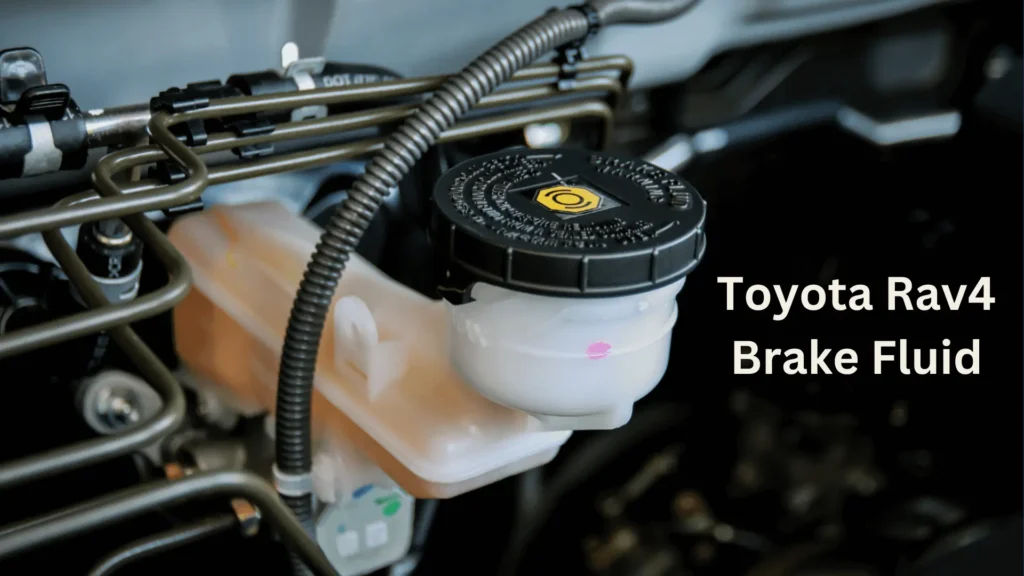Brake fluid is like the secret sauce for your car’s brakes. It’s a special liquid that makes sure when you press your foot on the brake pedal, your car stops smoothly and safely.
But, just like anything else, Toyota Rav4 brake fluid can get old and dirty. When this happens, it doesn’t work as well, and that’s not good for your car or your safety. That’s why it’s important to change the brake fluid in your car regularly, just like you change the oil.
If you drive an RAV4, this guide is for you! We’ll walk you through all the important stuff you need to know about changing your RAV4’s brake fluid. So, by the end of it, you’ll be all set to keep your car running smoothly and safely.
Toyota Rav4 Brake Fluid Type
When it comes to keeping your Toyota RAV4 brakes in top shape, choosing the right brake fluid is crucial. Luckily, all RAV4s, no matter the year they were made, work well with a couple of specific types of brake fluid.
For starters, there’s SAE J1703 and FMVSS No. 116 DOT 3 fluid. These are like the basic options, and they’re good for keeping your brakes working smoothly.
But if you’ve got a newer RAV4 made between 2019 and 2024, you’ve got some extra options. You can also use SAE J1704 and FMVSS No. 116 DOT 4 fluid. These are a bit fancier and offer some added benefits.
Now, what’s the difference between DOT 3 and DOT 4 fluid? Well, it’s all about water absorption. DOT 3 fluid doesn’t soak up as much water from the air as DOT 4 does. This means you might not have to change DOT 3 fluid as often.
However, DOT 4 fluid has its advantages. It can handle higher temperatures better, thanks to its higher boiling point. This makes it a safer choice, especially if you’re driving in hot weather or doing a lot of braking.
But here’s a really important tip: don’t mix different types of brake fluid in your RAV4! It’s like mixing up ingredients in a recipe – it just won’t work right. Stick to the types we mentioned earlier, and if you’re not sure which one to choose, it’s always a good idea to ask a professional for help. Your safety is worth it!
Toyota Rav4 Brake Fluid Change Frequency
Keeping your car’s brake fluid fresh is super important for keeping your ride safe and smooth. But how do you know when it’s time to change it?
Well, Toyota says you should check your brake fluid about every 6 months or 5,000 miles. If it’s running low, just top it up. But if it’s looking dark and murky, it’s time for a full swap-out.
Think of brake fluid like your favorite soda. When it’s fresh, it’s clear and bubbly. But as time goes on, it starts to get flat and loses its fizz. Brake fluid is kind of the same – when it’s new, it’s almost see-through with a bit of a yellow tint. But as it gets older, it turns into a dark brown or even black color.
And here’s why that matters: if you don’t change your brake fluid when it needs it, your brakes might start feeling “soft.” It’s like pressing on a sponge instead of a firm surface. Not only is it weird to drive like that, but it’s also not safe.
So, just like changing the oil in your car, don’t forget to keep an eye on your brake fluid. Your brakes – and your safety – will thank you for it!
How to Check Toyota Rav4 Brake Fluid?
Checking your car’s brake fluid level might sound complicated, but it’s pretty simple. Here’s how you do it:
First, pop open your car’s hood and walk over to the driver’s side. There, you’ll find the brake fluid reservoir. It’s usually a small, clear plastic container with a cap on top.
Next, take a good look at where the brake fluid level is inside the reservoir. Sometimes, it’s easy to see, especially if the fluid is dirty and leaves marks on the outside of the container.
But if you’re having trouble seeing the level, don’t worry. It could just mean the fluid is really low or that the reservoir is dirty on the outside.
Grab a damp cloth and give the outside of the reservoir a good wipe-down. This should clean it up and make it much easier to see where the fluid level is at.
You should also check: Toyota Rav4 Bolt Pattern (Explained)
Cost to Replace Brake Fluid
When it comes to getting your Toyota RAV4’s brake fluid changed, the cost can vary depending on where you go for the service. Usually, dealerships tend to charge more compared to independent auto shops.
On average, you can expect to pay between $80 to $130 for a brake fluid change for your RAV4. This estimate is based on the national average for all cars and doesn’t include any additional taxes, fees, or variations based on your specific vehicle model.
If you decide to take your car to a local garage instead of a dealership, you might end up paying less. But if you opt for the dealership, you might find yourself closer to the higher end of that price range. It’s all about finding the balance between quality service and cost.
Conclusion
In conclusion, maintaining your Toyota RAV4’s brake fluid is essential for keeping your car safe on the road. Regular checks and timely replacements can prevent brake issues and ensure smooth braking performance. Whether you choose a dealership or a local garage, investing in proper brake fluid maintenance is a small price to pay for peace of mind while driving.

